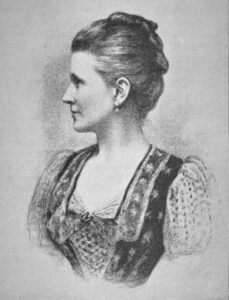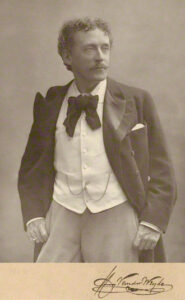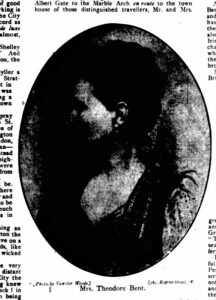Mabel Bent: A rare photograph attributed
One of those things that itches has just been scratched.

Theodore Bent’s ground-breaking monograph on Mashonaland – The Ruined Cities of Mashonaland (1892) – the volume that appeared following the year (1891) spent in ‘Rhodesia’ investigating the ruins of ‘Great Zimbabwe’ for Cecil Rhodes, and the work that was in effect to make Bent’s name, and him and his wife minor celebrities on both sides of the Atlantic, contains a charming portrait (page 61) of Mabel Bent – really charming actually, although adapted from the original photograph via the processes in those days required for printing; the image, however, has no attribution.
Charm? Yes, and obvious, in the professional lighting and a lightness of touch, almost modelling; and Mabel’s wild, long red hair (that famously captivated the villagers of Mashonaland (page 271)) is tamed, just, and her embonpoint sealed with an ‘M’; her dress is picturesque. It is a society portrait (we are talking London in the 1890s here), by a society photographer – but which one? This is the itch that needs scratching.

Then a surprise. Almost illegible, or whatever the word is for a photograph too dark to make out, the promise of a picture appears on page 621 of The Gentlewoman – The Illustrated Weekly Journal for Gentlewomen, No. 175, Vol. VII, for Saturday, November 11, 1893, within an article entitled “Gentlewomen ‘At Home’, no. CLXXV, Mrs. Theodore Bent”. We clearly read the sitter is Mrs. Theodore Bent. And, serendipitously, the photographer is a famous one – Henry Van der Weyde (1838–1924), the Dutch-born English painter and photographer, celebrated for his photographic portraits of the great and the good in the late 19th century; his studios equally fashionable, at “183 Regent-street, W.”

And there is something about the promise in this photograph – the outlines, vague suggestions in the almost ectoplasmic patches of the blacks and the whites. Surely, this photograph of Mabel Bent and the one in The Ruined Cities of Mashonaland are the same? The Bents had commissioned the colourful society photographer Henry Van der Weyde, the David Bailey of his day, hadn’t they, whose work Theodore and Mabel would show off in Bent’s bestseller ?
“One in two” – Behold they are the same! (© Ben Heaney 2020).
At this stage, both images go to Ben Heaney at Archaeopress, Oxford, to put Photoshop through its paces. This is his report: “To compare the two images identifiable reference points were taken – these were the neckline of the dress, the position of the earring and ear, the top of the hair and the ruffles of the dress sleeve. This allowed the images to be matched in size by lining up the reference points on separate layers in Adobe Photoshop. The higher quality image was on the top layer, the darker, poorer quality, image on the bottom layer. When the top layer was ‘faded out’ by adjusting the ‘opacity’ of the top layer, the two images clearly matched up.” (Ben Heaney, pers. comm. 21/09/2020)
Thus it can be revealed, the unattributed photograph of Mabel Bent on page 61 of The Ruined Cities of Mashonaland is based on an original by Henry Van der Weyde, the leading London portrait photographer of the period.
The itch scratched, we can let the Bents continue on their way, the E. Med. and Africa behind them, towards Arabia Felix and the last cycle of their odyssey together…
[See also the transcription of Mabel’s interview with The Gentlewoman] Leave a comment or contact us about this article
Leave a comment or contact us about this article